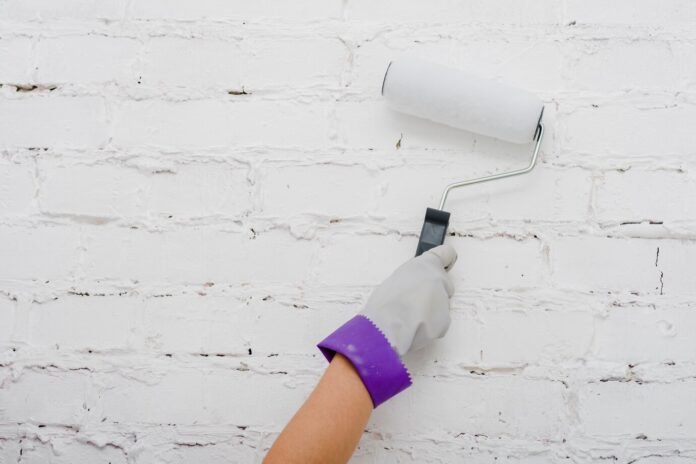Introduction
Limewash paint is an ancient yet increasingly popular choice for modern homes, offering a beautiful, breathable, and environmentally friendly finish. Made from natural limestone, water, and mineral pigments, limewash creates a soft, matte look with subtle variations in tone, giving walls a timeless, weathered charm. Unlike synthetic paints, limewash is free from harmful chemicals, making it ideal for both interior and exterior applications. Whether you’re aiming for a rustic, Mediterranean, or contemporary aesthetic, limewash paint provides a unique texture that synthetic alternatives cannot replicate. In this article, we’ll explore its benefits, applications, and how to use it effectively in your home.
1. What Is Limewash Paint?
Limewash is a traditional paint made from slaked lime (calcium hydroxide) mixed with water and natural pigments. It has been used for centuries in Europe and other parts of the world to protect and beautify buildings. Unlike modern acrylic or latex paints, limewash penetrates porous surfaces like brick, stone, and plaster, creating a chemical bond that allows the material to breathe. This prevents moisture buildup, reducing the risk of mold and mildew. The finish is soft, chalky, and slightly translucent, with a depth of color that changes subtly depending on the application technique and surface texture.
2. Benefits of Using Limewash Paint
One of the biggest advantages of limewash is its eco-friendliness—it contains no volatile organic compounds (VOCs) or synthetic additives, making it safe for both the environment and indoor air quality. Additionally, limewash has natural antibacterial and antifungal properties, which help maintain a healthier living space. Its breathability prevents trapped moisture, reducing the likelihood of peeling or blistering over time. Aesthetically, limewash offers a unique, artisanal look with its mottled, weathered appearance that synthetic paints struggle to imitate. Over time, it develops a beautiful patina, enhancing its character rather than deteriorating like conventional paint.
3. Where Can Limewash Paint Be Used?
Limewash is incredibly versatile and can be applied to a variety of surfaces, both indoors and outdoors. It works exceptionally well on porous materials like brick, stone, stucco, and plaster, making it ideal for accent walls, fireplaces, and historic home restorations. Exterior applications include façades, garden walls, and fences, where its breathability helps protect against weathering. While limewash is less commonly used on drywall or wood, specialized primers can help it adhere to these surfaces. However, for the best results, it should be applied to untreated, absorbent substrates that allow it to cure properly.
4. How to Apply Limewash Paint for the Best Results
Applying limewash requires a different technique than conventional paint. Since it is thin and watery, multiple coats (typically two to four) are needed to build up color and coverage. The application process involves using a large masonry brush or a specialty limewash brush to create textured, uneven strokes that enhance its natural aesthetic. Unlike synthetic paint, limewash should not be applied in thick layers—instead, it is worked into the surface in a cross-hatch motion. Before application, the surface must be clean, free of dust, and slightly damp to help the limewash absorb properly. After curing, a protective wax or sealant can be applied for added durability, especially in high-traffic areas.
5. Limewash vs. Modern Paints: Which Is Better?
While modern acrylic and latex paints offer convenience and a wide range of colors, limewash provides unique benefits that synthetic options cannot match. Traditional paints form a plastic-like film on surfaces, which can trap moisture and lead to peeling, especially on older buildings. Limewash, on the other hand, allows walls to breathe, preventing long-term damage. However, limewash does require more maintenance, as it may need reapplication every five to seven years, depending on exposure to weather. The choice between limewash and modern paint ultimately depends on the desired aesthetic, the building’s material, and environmental considerations.
6. Maintaining and Refreshing Limewashed Surfaces
Over time, limewash paint naturally weathers and fades, which many homeowners appreciate for its rustic charm. However, if you wish to maintain its original appearance, periodic touch-ups may be necessary. Since limewash is water-soluble, new layers can be applied directly over old ones without extensive prep work. For exterior surfaces, reapplying every few years helps maintain protection against the elements. If dirt or stains accumulate, gentle cleaning with water and a soft brush is usually sufficient—avoid harsh chemicals, as they can damage the finish. With proper care, limewashed walls can last for decades, developing a beautiful, lived-in character.
Conclusion
Limewash paint is more than just a decorative finish—it’s a sustainable, breathable, and historically rich option that brings depth and texture to any space. Whether you’re restoring an old home or adding character to a modern interior, limewash offers a unique blend of beauty and functionality. While it requires a different application technique and occasional maintenance, the results are well worth the effort.


